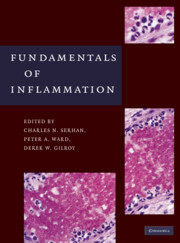Book contents
- Frontmatter
- Contents
- Contributors
- Preface
- PART I THE INFLAMMATORY RESPONSE – AN OVERVIEW
- PART II INDIVIDUAL CELL TYPES
- 4A Neutrophils I
- 4B Neutrophils II
- 5 Mast Cells as Sentinels of Inflammation
- 6 Basophils
- 7 Eosinophils
- 8 Macrophages
- 9 Lymphocytes
- 10 Fibroblasts and Stromal Cells
- 11 Neutrophil–Endothelial Cell Interactions
- PART III CHEMICAL MEDIATORS
- PART IV IMMUNOPHARMACOLOGY
- PART V INFLAMMATORY DISEASES/HISTOLOGY
- PART VI ANIMAL MODELS OF INFLAMMATION
- Index
- References
4A - Neutrophils I
from PART II - INDIVIDUAL CELL TYPES
Published online by Cambridge University Press: 05 April 2014
- Frontmatter
- Contents
- Contributors
- Preface
- PART I THE INFLAMMATORY RESPONSE – AN OVERVIEW
- PART II INDIVIDUAL CELL TYPES
- 4A Neutrophils I
- 4B Neutrophils II
- 5 Mast Cells as Sentinels of Inflammation
- 6 Basophils
- 7 Eosinophils
- 8 Macrophages
- 9 Lymphocytes
- 10 Fibroblasts and Stromal Cells
- 11 Neutrophil–Endothelial Cell Interactions
- PART III CHEMICAL MEDIATORS
- PART IV IMMUNOPHARMACOLOGY
- PART V INFLAMMATORY DISEASES/HISTOLOGY
- PART VI ANIMAL MODELS OF INFLAMMATION
- Index
- References
Summary
INTRODUCTION
Polymorphonuclear leukocytes or granulocytes are hematopoietically derived phagocytes characterized by multilobed nuclei and the presence of multiple, distinct granules within their cytoplasm. Three different polymorphonuclear leukocytes are distinguished according to their granular staining properties: neutrophils (polymorphonuclear neutrophils or PMNs), basophils, and eosinophils. Neutrophil granules stain preferentially with neutral dyes, whereas basophil granules stain with basic dyes, and eosinophilic granules stain with acidic colorants such as eosin. These three types of leukocytes differ not only in their tinctorial properties, but also in their functions and roles during the inflammatory process. They constitute key effector cells in innate immunity, and the frontline of host defense in response to foreign antigens and microorganisms. In this chapter, we will focus on the biology and role of neutrophils. The other polymorphonuclear leukocytes are discussed elsewhere.
NEUTROPHIL HOMEOSTASIS: MYELOPOIESIS AND DESTRUCTION
Neutrophil myelopoiesis is a closely regulated pro cess that begins with the differentiation of pluripotent stem cells into primitive myeloid progenitors, which in turn differentiate into specific myeloid precursors. Contact with specific adhesion molecules, hematopoietic growth factors, and cytokines promotes the progression of myeloblasts along unique pathways to mature as neutrophils, eosinophils, and basophils, as well as monocytes. The sequence that leads to neutrophil formation begins with the neutrophilic promyelocyte and progresses through several maturation steps (neutrophilic myelocyte, metamyelocyte, band cell, and mature neutrophil) (Figure 4A.1).
- Type
- Chapter
- Information
- Fundamentals of Inflammation , pp. 39 - 48Publisher: Cambridge University PressPrint publication year: 2010

